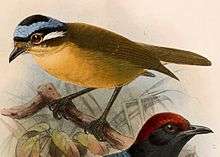Blue-capped ifrit
| Blue-capped ifrit | |
|---|---|
 | |
| Scientific classification | |
| Kingdom: | Animalia |
| Phylum: | Chordata |
| Class: | Aves |
| Order: | Passeriformes |
| Family: | Ifritidae |
| Genus: | Ifrita Rothschild, 1898 |
| Species: | I. kowaldi |
| Binomial name | |
| Ifrita kowaldi (De Vis, 1890) | |
The blue-capped ifrit (Ifrita kowaldi), also known as the blue-capped ifrita, is a small insectivorous bird endemic to the rainforests of New Guinea. It measures up to 16.5 cm long and has yellowish brown plumage with a blue and black crown. The male has a white streak behind its eye, while the female's is a dull yellow. It creeps on trunks and branches in search of insects.
The blue-capped ifrit is placed as the only member of the genus Ifrita, which historically has been placed in the family Cinclosomatidae or the Monarchidae. It now appears the bird is more properly placed in its own family Ifritidae. This enigmatic bird is one of only three bird genera known to have poisonous members, the others being the genus Pitohui, also from New Guinea, and the little shrikethrush (Colluricincla).
The blue-capped ifrit, like the hooded pitohui, sequesters batrachotoxin in its skin and feathers, which causes numbness and tingling to those who handle the bird. The toxin is acquired from part of its diet, specifically Choresine spp. beetles.[2]
Widespread and common throughout its large range, the blue-capped ifrit is evaluated as least concern on the IUCN Red List of Threatened Species.
See also
References
- ↑ BirdLife International (2012). "Ifrita kowaldi". IUCN Red List of Threatened Species. Version 2012.1. International Union for Conservation of Nature. Retrieved 16 July 2012.
- ↑ Dumbacher, J.P.; et al. (2004). "Melyrid beetles (Choresine): A putative source for the batrachotoxin alkaloids found in poison-dart frogs and toxic passerine birds". PNAS. 101 (45): 15857–15860. doi:10.1073/pnas.0407197101. PMC 528779
 . PMID 15520388.
. PMID 15520388.
Bibliography
- del Hoyo, J.; Elliot, A. & Christie D. (editors). (2007). Handbook of the Birds of the World. Volume 12: Picathartes to Tits and Chickadees. Lynx Edicions. ISBN 978-84-96553-42-2
